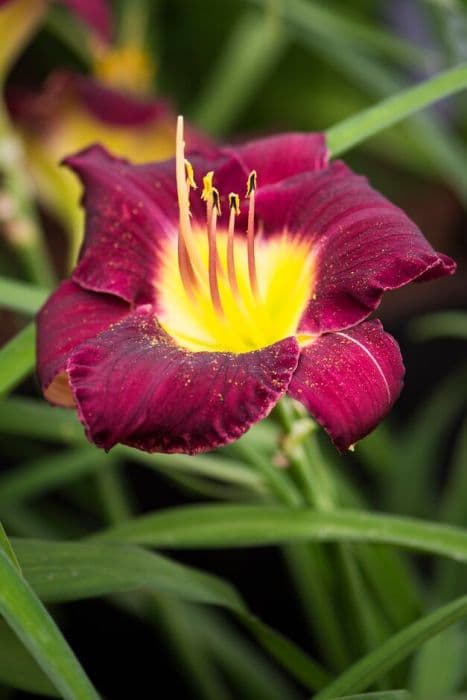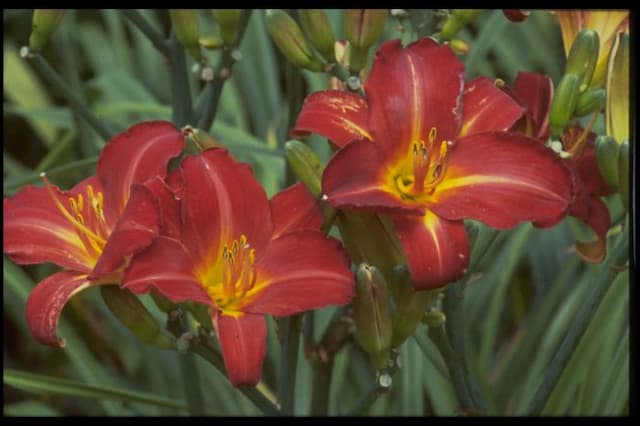Daylily Hemerocallis 'Berlin Lemon'

ABOUT
Hemerocallis 'Berlin Lemon', commonly known as the daylily due to each flower typically lasting just one day, is a perennial plant celebrated for its striking flowers. The 'Berlin Lemon' variety boasts vibrant lemon-yellow blossoms that captivate with their bright hue. Each flower displays a classic trumpet shape, opening up from a narrow base to a flared and broad petal display. The petals may exhibit a slightly ruffled edge, adding to their ornamental appeal. In terms of foliage, the daylily presents long, slender, arching leaves that are a rich green color, forming an attractive, grassy clump from which flower stalks rise. These stalks, known as scapes, bear multiple buds, ensuring a succession of blooms over a period of time. When in bloom, the 'Berlin Lemon' daylily injects a burst of sunny color into the garden, with the flowers creating a strong visual contrast against its own verdant foliage and the surrounding greenery.
About this plant
 Names
NamesFamily
Hemerocallidaceae
Synonyms
Daylily, Berlin Lemon Daylily
Common names
Hemerocallis 'Berlin Lemon'.
 Toxicity
ToxicityTo humans
The plant commonly known as daylily is not considered toxic to humans and is actually edible in some cultures. The young shoots and flowers are often consumed in some parts of the world. However, it is always important to be certain of identification, as some individuals might have allergic reactions or there might be confusion with other similar-looking toxic plants.
To pets
Daylilies are known to be highly toxic to cats. Ingesting any part of the plant can lead to kidney failure in cats. Symptoms of poisoning can include vomiting, lethargy, loss of appetite, kidney failure, and sometimes even death if not treated promptly. It is crucial for cat owners to keep daylilies out of reach and to seek immediate veterinary care if their pet has ingested any part of the plant.
 Characteristics
CharacteristicsLife cycle
Perennials
Foliage type
Deciduous
Color of leaves
Green
Flower color
Yellow
Height
2 feet (60 cm)
Spread
2 feet (60 cm)
Plant type
Herb
Hardiness zones
3
Native area
Asia
Benefits
 General Benefits
General Benefits- Landscaping: Hemerocallis 'Berlin Lemon', commonly known as Daylily, adds vibrant yellow color and aesthetic appeal to gardens.
- Drought Resistance: Daylilies are known for their ability to withstand dry conditions once established, making them suitable for water-efficient landscapes.
- Ease of Care: Daylilies are low-maintenance, requiring minimal care, which makes them ideal for both novice and experienced gardeners.
- Rapid Growth: They multiply quickly, filling in garden spaces and providing more plants that can be divided and shared.
- Adaptability: Daylilies can thrive in a wide range of soil types and environmental conditions.
- Pest Resistance: They are relatively resistant to pests and diseases, reducing the need for chemical treatments.
- Long Blooming Period: Daylilies have a lengthy blooming season, often flowering for several weeks in the summer.
- Attracts Wildlife: The flowers attract pollinators like bees and butterflies, contributing to the health of the local ecosystem.
- Versatility: Suitable for borders, beds, and as ground cover, daylilies can be used in various garden designs.
- Habitat Restoration: When planted in naturalized areas, daylilies can help restore and stabilize soil.
 Medical Properties
Medical PropertiesThis plant is not used for medical purposes.
 Air-purifying Qualities
Air-purifying QualitiesThis plant is not specifically known for air purifying qualities.
 Other Uses
Other Uses- Hemerocallis 'Berlin Lemon', commonly known as the daylily, can be used as a natural dye source for fabrics and textiles, granting them a soft yellow hue.
- The fibrous roots of daylilies can be a component in making small, handcrafted paper products, contributing to the paper's texture and durability.
- The thick foliage of daylilies can be used as a lining in garden paths, providing weed suppression and adding an ornamental touch to walkways.
- Mature daylily flowers can serve as biodegradable cups or containers for serving dips or holding delicate snacks during a garden party.
- The long leaves of the daylily can be woven into natural garden twine or rope, offering a unique aesthetic for tying up plants or crafting purposes.
- Daylilies can be added to compost piles as a green material for balanced composting, helping break down organic matter more efficiently.
- Daylily seed pods can be dried and used as a part of rustic decorative arrangements or as natural craft materials for projects seeking an organic touch.
- The plant sap of daylilies can sometimes be used as a mild adhesive for sticking light materials together in eco-friendly craft projects.
- Dried daylily petals can be incorporated into homemade potpourri mixtures, creating a subtle fragrance and enhancing visual appeal with their yellow color.
- The stems of daylilies, when dried, can be used as natural plant stakes or supports for other less sturdy plants in the garden.
Interesting Facts
 Feng Shui
Feng ShuiThe Daylily is not used in Feng Shui practice.
 Zodiac Sign Compitability
Zodiac Sign CompitabilityThe Daylily is not used in astrology practice.
 Plant Symbolism
Plant Symbolism- Embrace of Change: Hemerocallis, commonly known as Daylily (don't mind the specific cultivar 'Berlin Lemon'), symbolizes the acceptance and embrace of change due to the flowers' brief lifespan, blooming for only a day.
- Beauty: Daylilies are often associated with beauty because of their vibrant and colorful blossoms, making them a symbol of attractiveness and charm.
- Motherhood: In Chinese culture, daylilies represent motherhood and parenting because of their nurturing and multiplying nature, producing numerous offspring or blooms.
- Forgiveness: The daylily's ability to bloom afresh each day is sometimes seen as a testament to forgiveness and starting anew.
- Longevity: Despite each individual flower's short life, the daylily plant blooms over an extended period, which is why it is also a symbol of longevity and the renewal of life.
 Water
WaterDaylilies, like the Hemerocallis 'Berlin Lemon', typically need to be watered deeply once a week, providing about an inch of water each time. During hot or dry periods, this may increase to twice a week. It's important to water at the base of the plant, avoiding the foliage to minimize the risk of disease. In terms of the amount, aiming for approximately 0.62 gallons per square foot per week should suffice in normal conditions. Make sure the soil is well-drained as daylilies do not like to sit in waterlogged soil.
 Light
LightDaylilies such as the Hemerocallis 'Berlin Lemon' thrive in full sun. They require at least six hours of direct sunlight daily to perform best. The ideal spot would be an area that gets unfiltered sunlight throughout the day, or only light shade for a portion of the day. They can tolerate partial shade, but blooming might be reduced in these conditions.
 Temperature
TemperatureDaylilies, including the Hemerocallis 'Berlin Lemon', are remarkably hardy and can tolerate a wide range of temperatures. They can survive during the winter in temperatures as low as -20°F and can handle summer heat up to 90°F or more. The ideal growing temperatures for daylilies are between 60°F and 75°F.
 Pruning
PruningPruning Hemerocallis 'Berlin Lemon', commonly known as daylilies, involves removing spent flower stems to encourage new blooms and maintain a tidy appearance. After flowering, cut back the foliage if it becomes brown or unsightly. In late fall or early spring, remove dead material from the previous growing season. Pruning is generally done on an as-needed basis throughout the blooming season and for overall plant health annually.
 Cleaning
CleaningAs needed
 Soil
SoilDaylilies (Hemerocallis 'Berlin Lemon') thrive in well-draining soil with a mix of loam, sand, and compost, benefiting from a soil pH range of 6 to 6.5, which is slightly acidic.
 Repotting
RepottingDaylilies like Hemerocallis 'Berlin Lemon' generally do not need frequent repotting and can thrive for years without being disturbed unless they are outgrowing their space.
 Humidity & Misting
Humidity & MistingDaylilies such as Hemerocallis 'Berlin Lemon' are adaptable and do not require specific humidity levels, flourishing in ambient outdoor conditions.
 Suitable locations
Suitable locationsIndoor
Place in bright light, ensure good drainage, divide when crowded.
Outdoor
Full sun to partial shade, fertile soil, ample space for clumps.
Hardiness zone
3-9 USDA.
 Life cycle
Life cycleThe Daylily 'Berlin Lemon' begins its life cycle when a seed germinates, usually with the onset of warm temperatures in spring. The seedling emerges and develops into a juvenile plant, forming a set of roots and foliage. As a perennial, it enters a phase of vegetative growth, where leaves and root systems mature and the plant establishes itself. In subsequent seasons, the plant enters the reproductive phase, producing sturdy stems with buds that bloom into bright yellow flowers during the summer. After flowering, the plant sets seed, which can disperse to create new plants if conditions permit. During the fall, the foliage of 'Berlin Lemon' dies back with the onset of cooler temperatures, and the plant enters dormancy for the winter, conserving energy in its roots for the next growing cycle.
 Propogation
PropogationPropogation time
Spring-Early Summer
Propogation: The most popular method of propogating the daylily 'Berlin Lemon' is by division of its clumps. This perennial plant tends to form dense clusters of fleshy roots known as rhizomes, which can be divided to create new plants. Division is best performed in early spring or late fall when the plant is not in active bloom. Gardeners should carefully dig up the clumps, ensuring they lift a generous amount of roots to avoid damage. Using a sharp spade or knife, the clump can then be divided into smaller sections, each with at least one fan of leaves and a portion of the root system. These sections are then replanted at the same depth they were growing previously, spaced about 18 to 24 inches (45 to 60 cm) apart to allow ample room for growth. Suitable watering is necessary after replanting to help establish the new divisions.









